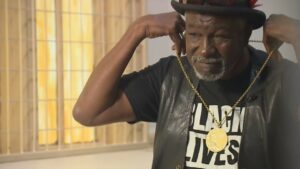Ringside Report Looks Back at the 1972 Olympic Gold Winner and Former NABF Middleweight Champion Sugar Ray Seales
By Donald “Braveheart” Stewart
He was the only US fighter to go to the Munich Olympics and return home with a gold medal strung around his neck. Who? Sugar Ray Seales 56-8-3, 33 KOs, that’s who! He was a man for whom statues should be made, but instead it has been a steady decline since leaving the ring. A southpaw middleweight, Seales got in the ring with one of the best of his times – Marvin Hagler – not once, twice but three timers m’lady. A former NABF and USBA middleweight champion, the last reports of this ring legend are that he is being cared for in a facility.
The most recent interview and mention of this Olympian was from Matt Driscoll, speaking to a former News Tribune sports columnist, John McGrath, who interviewed Seale this year – 2023 – for The News Tribune. It makes for very difficult reading. Talking to Driscoll, McGrath was quoted in reflective mood about the effect the sport has upon its athletes: “It’s fabulous. It gets your heartbeat up, and your pulse just going. It’s absolutely incredible, and yet, it seems like, for so many people … it leaves them in bad shape. Every time I hear a name like Ray Seales, those two worlds kind of converge — the part that’s glamorous, and the part that’s not so glamorous.”
Seales was born in the US Virgin Islands, in 1952 where his family were stationed due to his father’s service. His father boxed for the U. S. Army, then, in 1965, the family moved to Tacoma, Washington. Ray was one of three brothers who boxed – the others being Wilbur and his half-brother, Dale Grant. Moving Tacoma meant that Seales was going to be quoted alongside such luminaries training there as Johnny Bumpus and Leo Randolph.
His amateur career was a glittering one, with a reported record of 338-12. He became the 1971 AUU national light welterweight champion, then the 1972 Golden Gloves champ, before making the Olympic team. At the Olympics, Seale fought five times. He began by beating the East German Ulrich Beyer, before dispensing of Ireland’s Jim Montague. In the quarter final, he faced Cuba’s Andres Molina, before Yugoslavia’s Zvonimir Vujin was swept away in the penultimate fight. It left Bulgaria’s Angel Angelov and a 3-2 points win was enough to seal his fate with the only gold for a team that included Jesse Valdez, Marvin Johnson and Duane Bobick. His return to the US saw Seale being flown to Cheney Stadium, where a crowd of 5,000 awaited him. In his interview Seales lit up when speaking of such adulation: “It was a party. It was a big celebration. I’d done something. I’d done the best thing I could do for America.”
But Seale was of a generation where the Olympics were revered but the Olympians less so once they left the amateur code. And so, on the 11th of January 1973, Seales turned pro Tacoma with a points win over 8 rounds against Gonzalo Rodriguez. By the time he had fought professionally 11 times, he had turned only 21 years old!
His first title came when he fought John L. Sullivan on the 8th of June 1974, in Lacey with a 2nd round stoppage win and the Pacific Northwest belt now his.
But it is his three fights against Hagler that caught the most attention. On the 30th of August 1974, in Boston he faced him first: both were undefeated. It was a narrow loss and led, three months later, to a rematch in Seattle on the 26th of November. It was fought to a draw. Ove 4 years later, back in Boston, he faced him again. On the 3rd of February 1979, Seales was knocked down three times in the first round and it was his second, and most devastating, loss to Hagler.
later, to a rematch in Seattle on the 26th of November. It was fought to a draw. Ove 4 years later, back in Boston, he faced him again. On the 3rd of February 1979, Seales was knocked down three times in the first round and it was his second, and most devastating, loss to Hagler.
Seales was always mentioned amongst others as a possible contender but never got the opportunity to fight for a world title. We in the UK got to know him when he fought European Champion and fellow 1972 Olympian, Alan Minter on the 7th of December 1976 at the Royal Albert Hall and losing in a 5th round stoppage.
By then he had fought twice for the NABF middleweight titles, winning both times – on points against George Cooper in March of 1976, and knocking Bobby Hoye out on the 4th in May of the same year.
In 1977, Seales found himself in the ring on 3 occasions with titles on the line: the NABF middleweight belt was secured against Tony Gardner by knocking him out in the 4th in May, and then in June, he got a wide points win against Vicente Medina – both fights were in Anchorage. In December it was the IBF USBA middleweight title he won by beating Doug Demmings on points in Chicago. In 1981 he fought again for that title and beat Sammy Nesmith in Indianapolis, stopping him in the 5th and then once more in 1982, he was up against an unbeaten James Shuler in McAfee – this time though he lost by some distance on points.
The end was night and on the 22nd of January 1983, he took on Max Hord, winning in a 1st round stoppage but the time had come to get out of the ring. When he did, he came out with injuries sustained. These left him legally blind in both eyes. A subsequent operation apparently fixed the issue with his retinas and, his father, having served one noble cause, Seales went on to serve another. He was a schoolteacher of autistic children following his retirement from the ring. Having spent 17 years in that job he retired in 2004 and moved to Indianapolis with his wife.
 His time in the ring has been honored by induction into Tacoma-Pierce County Sports Hall of Fame and the Indiana Boxing Hall of Fame in their inaugural class. But by 2018, he was according to his interview, “flat broke.” His wife passed and he returned to Tacoma, but there is little by way of fame, and less by way of fortune. People have tried to help including a benefit concert in 1984, with Sammy Davis Jr. and Muhammad Ali. Now he is reported as living in a Hilltop shelter. He still possesses his American Express Card – “I never leave home without it,” he says as he produces the gold medal that came back uniquely with him in 1972. His words, of a 70-year-old man, blind and alone, are testimony to being abandoned by a sport that would have found a pedestal just for him, in times gone past. And so, I quote from his interview and leave you with his sad words on which to ponder. ““It’s not supposed to be like this. I expected a room or a place, you know? Because I took care of Tacoma. … I had so many friends here. I don’t need a big mansion, or a big house, I just need a place to stay.”
His time in the ring has been honored by induction into Tacoma-Pierce County Sports Hall of Fame and the Indiana Boxing Hall of Fame in their inaugural class. But by 2018, he was according to his interview, “flat broke.” His wife passed and he returned to Tacoma, but there is little by way of fame, and less by way of fortune. People have tried to help including a benefit concert in 1984, with Sammy Davis Jr. and Muhammad Ali. Now he is reported as living in a Hilltop shelter. He still possesses his American Express Card – “I never leave home without it,” he says as he produces the gold medal that came back uniquely with him in 1972. His words, of a 70-year-old man, blind and alone, are testimony to being abandoned by a sport that would have found a pedestal just for him, in times gone past. And so, I quote from his interview and leave you with his sad words on which to ponder. ““It’s not supposed to be like this. I expected a room or a place, you know? Because I took care of Tacoma. … I had so many friends here. I don’t need a big mansion, or a big house, I just need a place to stay.”
On August 25, 2019 RSR’s Publisher “Bad” Brad Berkwitt interviewed Seales on his show.
Click Here to Order Boxing Interviews Of A Lifetime By “Bad” Brad Berkwitt


